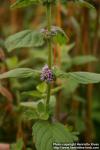(Also see Mints high in menthol).
Latin: Mentha-species:
Water mint, Mentha aquatica
Brook mint, Wild mint, Mentha arvensis
Silver mint, Mentha longifolia
European pennyroyal, Mentha pulegium
Spearmint, Mentha spicata, and curled mint, Mentha spicata 'Crispa'
and other species, subspecies, varieties, forms, hybrids and cultivars in the genus Mentha.
Family: Lamiaceae, mint family.
Parts used: Aboveground parts, in or out of flower.
Taste: To me, these taste either of catpiss or of used dishwashing water. This is individual, though; some people absolutely love the taste of spearmint, silver mint, or even pennyroyal.
4 humors: Warmish.
Actions:
- Digestive.
- Carminative.
- Good for various cramps: digestive, respiratory (= coughs), and menstrual.
Food uses:
- People do use these in various salt or sweet foods. I haven't even added twigs of these to my summer water jar, for a long long time.
Notes:
- Mints are notoriously difficult to key out. What you call "pineapple mint" in your garden might look totally different from your next door neighbor's pineapple mint (unless you've given them a shoot of your plant, to plant). Ditto for "Moroccan mint": there are at least a dozen separate mints of that name. They have a spearminty taste in common, and might or might not be either curled or spear mints. (There are quite a lot of curled mints, too. I've had at least four different ones in my garden, so far.)
- Mints hybridize readily.
- There are about 4500 recognized Mentha "names", in an official mint database: that's species, subspecies, varieties, forms, hybrids and cultivars. Experts estimate that, were these actually all compared to each other, that number would shrink by about 2000.
- There are really only about 20 true species of Mentha. These are the only ones that will come true to seed.
- If you wish to keep your mints "true", don't let them flower and set seed. Else, you might find that your nice patch of, say, orange mint is suddenly overrun by something quite like water mint.
Experiences:
- Think of the catpissy mints as akin to catnep (Nepeta cataria) and use them in similar ways: for various digestive upsets, for their calming action, and for menstrual pain. (Also do magnesium and vitamin B for menstrual cramps!)
- Spearmint has an edge to it that's missing from a lot of the other non-mentholy species of Mentha. Use that if you need some more power in your tea or tincture blend. If you need even more power, go for the mentholy species instead.
Comments on Facebook:
http://www.facebook.com/note.php?note_id=378175028860601
- From Deborah Bountifull D.:
So THAT'S why all my mints "mixed"
25 February at 04:02 - From Joanna J.:
This one made me laugh. I love mint a lot more than this writer does. I drink mint tea every day.
24 February at 16:57 - From Mike M.:
... catpiss or of used dishwashing water. Nice description, eh? She is refering to the non-menthol ones in this post. The better tasting, peppery mints are in another post.
24 February at 19:46
Please add your own experiences etc. in the comments!
Mints will be in my next book, out in 2013 or so. That book will be quite similar to my fabulous herb book Practical Herbs, with more herbs, more fast-working tips, and more basics.
Also see Peppery mints - Herb of the week: Mentholy Mints.


